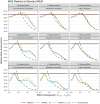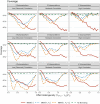Leveraging information from secondary endpoints to enhance dynamic borrowing across subpopulations
- PMID: 39441727
- PMCID: PMC11498028
- DOI: 10.1093/biomtc/ujae118
Leveraging information from secondary endpoints to enhance dynamic borrowing across subpopulations
Abstract
Randomized trials seek efficient treatment effect estimation within target populations, yet scientific interest often also centers on subpopulations. Although there are typically too few subjects within each subpopulation to efficiently estimate these subpopulation treatment effects, one can gain precision by borrowing strength across subpopulations, as is the case in a basket trial. While dynamic borrowing has been proposed as an efficient approach to estimating subpopulation treatment effects on primary endpoints, additional efficiency could be gained by leveraging the information found in secondary endpoints. We propose a multisource exchangeability model (MEM) that incorporates secondary endpoints to more efficiently assess subpopulation exchangeability. Across simulation studies, our proposed model almost uniformly reduces the mean squared error when compared to the standard MEM that only considers data from the primary endpoint by gaining efficiency when subpopulations respond similarly to the treatment and reducing the magnitude of bias when the subpopulations are heterogeneous. We illustrate our model's feasibility using data from a recently completed trial of very low nicotine content cigarettes to estimate the effect on abstinence from smoking within three priority subpopulations. Our proposed model led to increases in the effective sample size two to four times greater than under the standard MEM.
Keywords: Bayesian model averaging; basket trials; dynamic borrowing; multisource exchangeability models; secondary endpoints; subpopulation analysis.
© The Author(s) 2024. Published by Oxford University Press on behalf of The International Biometric Society.
Conflict of interest statement
None declared.
Figures






References
-
- Bell E. T. (1938). The iterated exponential integers. Annals of Mathematics, 39, 539–557.
-
- Chen C., Han P., He F. (2022). Improving main analysis by borrowing information from auxiliary data. Statistics in Medicine, 41, 567–579. - PubMed
-
- Chen C., Wang M., Chen S. (2023). An efficient data integration scheme for synthesizing information from multiple secondary datasets for the parameter inference of the main analysis. Biometrics, 79, 1–14. - PubMed
MeSH terms
Grants and funding
LinkOut - more resources
Full Text Sources
Medical

